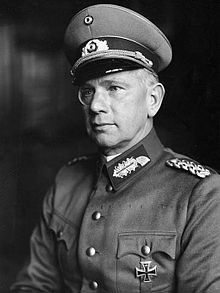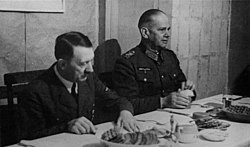Walter von reichenau
Walter Karl Ernst August von Reichenau (16 August 1884 in Karlsruhe – 17 January 1942 in Poltava) was a field marshal in the Nazi German Wehrmacht during World War II.. Reichenau commanded the 6th Army, during the invasions of Belgium and France. During Operation Barbarossa, the invasion of the Soviet Union, he continued to command the 6th Army as part of Army Group South as it captured the Ukraine and advanced deep into the USSR.
While commanding the 6th Army during Operation Barbarossa in 1941, he issued the notorious Order of Severity that encouraged German soldiers to murder Jewish civilians on the Eastern Front. Reichenau's troops cooperated with the Einsatzgruppen in the commission of the massacre of more than 33,000 Jews at Babi Yar and assisted with other crimes against humanity that occurred in areas under his command during the Holocaust.
Biography
Childhood and youth
The son of Prussian Lieutenant General Ernst August von Reichenau (1841–1919), Walter von Reichenau was born in 1884 in Karlsruhe. One of his brothers was Ernst von Reichenau. Walter joined the Prussian Army as an artillery officer cadet on March 14, 1903. He then attended the Prussian War Academy and later served as Max Hoffmann's staff officer in World War I.
At the start of the war, Reichenau was an adjutant to the 1.er Artillery Regiment of Campaign of the Guard and in this position he was promoted to captain on 28 November 1914 and was awarded the Iron Cross 2nd and 1st class in the course of the year. The following year he was transferred to the German General Staff and in the course of 1915 he served as Second Staff Officer (Ib) of the 47th Reserve Division and then as First Staff Officer of the 7th Division. of Cavalry.
Reichenau's early years are described in conflicting terms, both progressive-minded and brutal, with a history of executing soldiers who were AWOL, even in peacetime. Highly unconventional, he was an avid outdoorsman, spoke English at home, and, in contrast to his later activities in Russia, insisted on supporting events for Jewish World War I veterans in full military uniform, even after they Hitler came to power. In April 1919 he married the Silesian aristocrat Alexandrine Gräfin Maltzan Freiin zu Wartenberg und Penzlin (1895-1984).
Prewar
After the war, he joined the Grenzschutz Ost Freikorps as a staff officer, serving in Silesia and Pomerania. In 1919, Reichenau joined the newly established Reichswehr of the Weimar Republic. The officer corps of the new armed forces was limited to just 4,000 officers and there was no General Staff. Reichenau took a post in the Truppenamt, which was the "clandestine" equivalent of the General Staff formed by Hans von Seeckt. He was promoted to major in 1924, to lieutenant colonel on April 1, 1929, and to colonel on February 1, 1932. In 1930, Reichenau was appointed Chief of Staff of the Signal Inspector in the Reichswehr Ministry. He was later introduced to Hitler by his uncle, a diplomat, in April 1932. Extremely ambitious, he saw the Nazi Party as a means by which he could further his career, so he broke with the pro-monarchist politics of the Prussian military caste. and became a devoted Nazi.
As an outspoken ally and supporter of Hitler and the Nazi Party, Reichenau soon came into conflict with cabinet member and eventual chancellor Kurt von Schleicher, who used his authority to transfer him from his prestigious position in Berlin to the headquarters of the East Prussian military district, a relative backwater. In East Prussia, Reichenau served under the command of General Werner von Blomberg, Schleicher's fellow exile. Reichenau and Blomberg became political allies within the army and it was Reichenau who introduced Blomberg to Hitler. Blomberg, who had a reputation for being manipulated by Reichenau, became captivated by Hitler and both men soon used their Nazi party connections to further their military careers. When Hitler came to power in January 1933, Blomberg became Minister of War. One of his first acts was to promote Reichenau to the head of the powerful Ministerial Office, acting as liaison officer between the Army and the Nazi Party. He played a leading role in persuading various Nazi leaders such as Göring and Himmler that the power of Ernst Röhm and the SA must be destroyed if they wanted the army to support the Nazi government. This led directly to the Night of the Long Knives on June 30, 1934.
In August 1935, Reichenau was promoted to lieutenant general (Generalleutnant) and was also appointed to command the military forces in Munich. Reichenau was one of Hitler's favorite generals and his first choice for commander-in-chief of the Heer in 1934.
Reflecting Reichenau's preference for political affairs assignments, Blomberg sent Reichenau to China in May 1934 to support General Alexander von Falkenhausen's military mission. Foreign Minister Konstantin von Neurath and Herbert von Dirksen the German ambassador to Japan raised objections to Reichenau's dispatch, fearing that the assignment of an officer to his position might jeopardize Germany's relationship with Japan.
In 1938, after the Blomberg-Fritsch scandal, in which Fritsch was ousted from command of the army, Reichenau again became Hitler's first choice to lead the Heer, but older leaders such as Gerd von Rundstedt and Ludwig Beck became They refused to serve under Reichenau and Hitler was forced to relent.
World War II
In September 1939, Reichenau assumed command of the 10th Army during the German invasion of Poland and was the first German to swim across the Vistula River. After the campaign, he was awarded the Knight's Cross of the Iron Cross for their role during the fighting. During the last two years before the outbreak of World War II, most of the German General Staff were so alarmed by Hitler's rush towards general war and so convinced of the Germany's insurmountable strategic disadvantages that they planned to overthrow Hitler. When Reichenau learned of Hitler's plans to invade the Netherlands shortly after the Polish campaign, he opined that this was "absolute madness" (völlig wahnsinnig) and in November 1939 he met with various leaders of the army-linked German Resistance, not only revealing the plans for the invasion, but even going so far as to suggest means by which the Dutch might thwart the invaders. Despite the efforts of Reichenau and others in the German Resistance and for various reasons, the warnings were ignored by the Allies; Reichenau backed away from his opposition to Hitler. In 1940 he led the 6th Army during the invasion of Belgium and France. On July 19, 1940, he was promoted to field marshal by Hitler during the 1940 Field Marshal Ceremony. Accompanied by his deputy officer, General Friedrich Paulus, the Reichenau accepted the surrender of Belgium at the hands of its king, Leopold III.
During the German invasion of the Soviet Union, as commander of the 6th Army, he led his army into the heart of the Soviet Union, during the summer of 1941. The 6th Army was part of Army Group South and he captured the cities of Kiev, Belgorod, Kharkiv and Kursk. During its offensive into the Soviet Union, the German Army was faced with a number of superior tank designs. Reichenau inspected the Soviet tanks he found, climbed into each tank and measured its armor plate. According to staff officer Paul Jordan, after examining a T-34, Reichenau told his officers, "If the Russians ever produce it on an assembly line, we will have lost the war." During the campaign in the south of the Soviet Union, directly involved soldiers under his command in collaborating with SD and SS troops in the execution of Jews, such as the Babi Yar Ravine Massacre in Kiev, where 30,000 Ukrainian Jews were killed.
On November 30, 1941, Hitler relieved Field Marshal von Rundstedt of command of Army Group South and promoted Reichenau to take his place. On Hitler's personal recommendation, Friedrich Paulus, a Reichenau protégé and former member of his command staff, was promoted to command the 6th Army.
Death
On January 12, 1942 ―at the age of 57―, after going for a run through the snowy forest of Poltava (Ukraine), at -20 °C, he suffered a cerebral hemorrhage that caused him to go into a coma. Two days later, at Hitler's insistence, he was put on a plane that took him to Lviv, Ukraine. He then suffered serious head injuries when the flight carrying him back to Leipzig for medical attention crashed on landing in Lviv. However, German historian Walter Görlitz wrote that the plane merely made an emergency landing in a field in the Soviet Union, and that Reichenau actually died of cardiac arrest. Whether he died from the stroke or from the injuries sustained in the accident.
He was replaced in command of Army Group South by Fedor von Bock and received a state funeral.
War crimes
Reichenau's uncle was an ardent supporter of the Nazis and introduced him to Adolf Hitler in April 1932. Reichenau joined the Nazi Party, although doing so was in violation of army regulations established by Seeckt to isolate the army of national politics. Reichenau was an anti-Semite convinced that he equated Judaism with Bolshevism and perceived both as an Asian threat to Europe. Since he died in 1942, he was never convicted of war crimes, but was part of the German General Staff and Armed Forces High Command collectively indicted at the Nurembergs. His "Reichenau Order" was specifically cited in the indictment., commonly known as the October 1941 Order of Severity, which supported Nazi genocidal policies: The only objection Reichnenau raised to the Einsatzgruppen's activities in his sector was when they were killing so many Jews, so quickly, that they began to creating ammunition shortages in his sector of operations, an issue he addressed by recommending that the SS and SD limit themselves to two bullets per Jew.
Reichenau was in charge of the area of operations in which the SS, Einsatzgruppen and Ukrainian auxiliaries committed the massacre of more than 33,000 Jews at Babi Yar. Later that year, in August, Reichenau was also directly implicated in the murder of ninety Jewish children in the 1941 Bila Tserkva massacre, after being asked by Helmuth Groscurth to do everything possible to prevent the murders.
Biography
- Adam, Wilhelm; Ruhle, Otto (2015). With Paulus at Stalingrad (in English). Pen and Sword. ISBN 1-4738-3386-8. OCLC 910856026.
- Mitcham, Samuel W. (2008). The rise of the Wehrmacht: the German armed forces and World War II (in English). Santa Barbara, California (USA): Praeger Security International. ISBN 978-0-275-99642-0. OCLC 562448592.
- Fellgiebel, Walther-Peer (2000). Die Träger des Ritterkreuzes des Eisernen Kreuzes, 1939-1945: die Inhaber der höchsten Auszeichnung des Zweiten Weltkrieges aller Wehrmachtteile (in German). Friedberg, Germany: Podzun-Pallas. ISBN 3-7909-0284-5. OCLC 17650176.
- Parssinen, Terry M. (2004). The Oster conspiracy of 1938: the unknown story of the military plot to kill Hitler and avert World War II (in English). London (United Kingdom): Pimlico. ISBN 1-84413-307-9. OCLC 59316059.
- Weinberg, Gerhard L (2010). Hitler's Foreign Policy 1933-1939: The Road to World War II (in English). Oxford, United Kingdom: Enigma Books. ISBN 978-1-936274-84-0. OCLC 946167604.
- Kühne, Thomas (2010). Belonging and genocide: Hitler's community, 1918-1945 (in English). New Haven, Connecticut: Yale University Press. ISBN 978-0-300-16857-0. OCLC 808346527.
- Stahel, David (2013). Operation Typhoon: Hitler's march on Moscow, October 1941 (in English). Cambridge University Press. ISBN 978-1-107-31477-1. OCLC 827944799.
- Mitcham, Sameul W; Mueller, Gene (2012). Hitler's Commanders: Officers of the Wehrmacht, the Luftwaffe, the Kriegsmarine, and the Waffen-SS. (in English) (2nd edition). Lanham, Maryland: Rowman & Littlefield Publishers. ISBN 978-1-4422-1154-4. OCLC 855502110.
- Knopp, Guido (1998). "Hitler's Warriors. Paulus the Defector.». ZDF (Mainz, Germany).
- Glantz, David M.; House, Jonathan (2009). To the gates of Stalingrad: Soviet-German combat operations, April-August 1942 (in English). Lawrence, Kansas: University Press of Kansas. ISBN 978-0-7006-1630-5. OCLC 275152784.
- Liddell Hart, Basil (1948). The German generals talk (in English). New York (USA): Morrow. ISBN 0-688-06012-9. OCLC 318454180.



